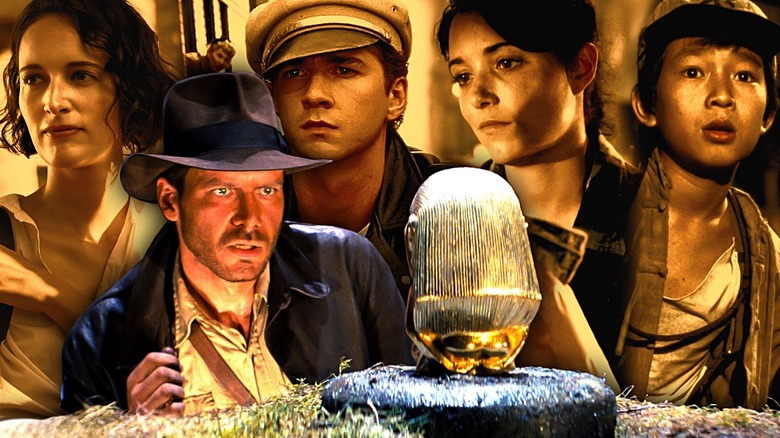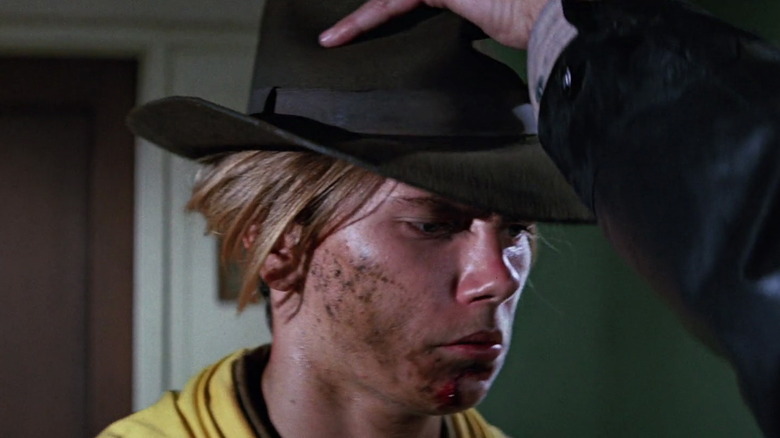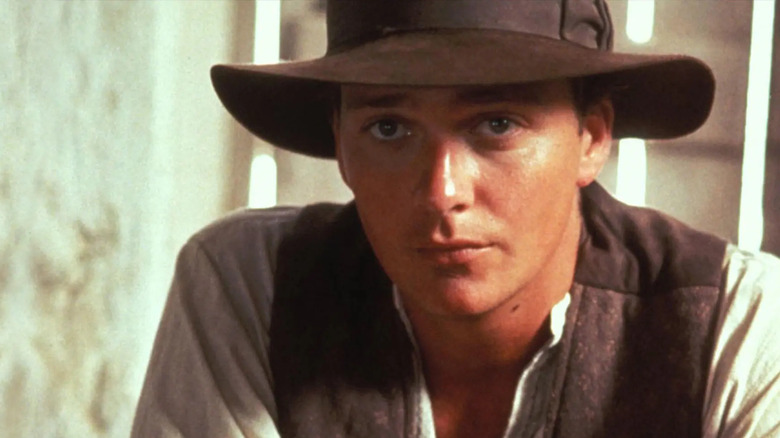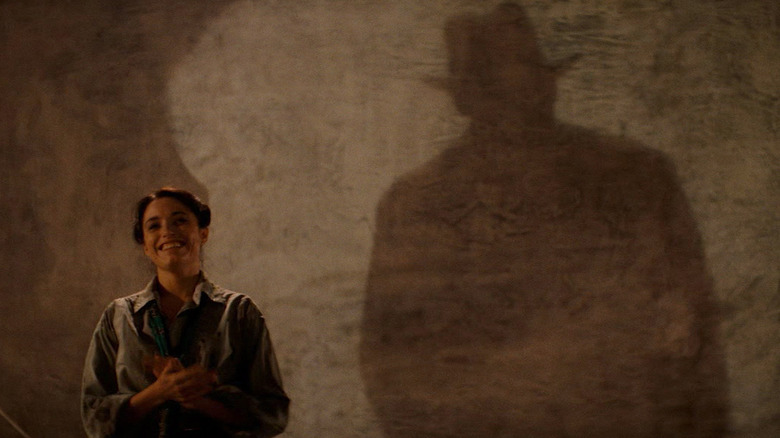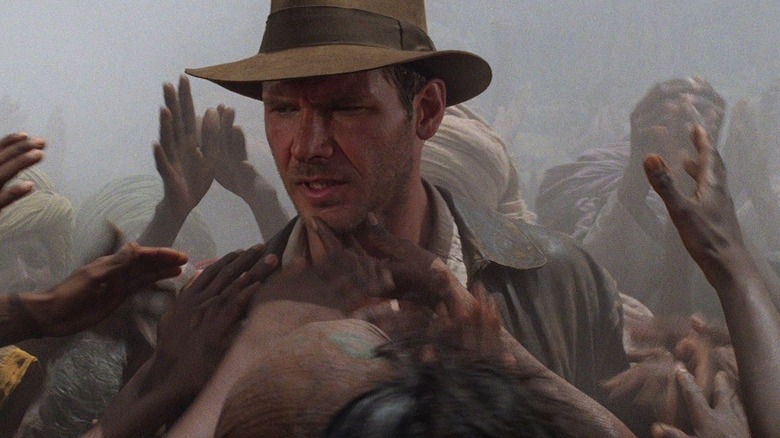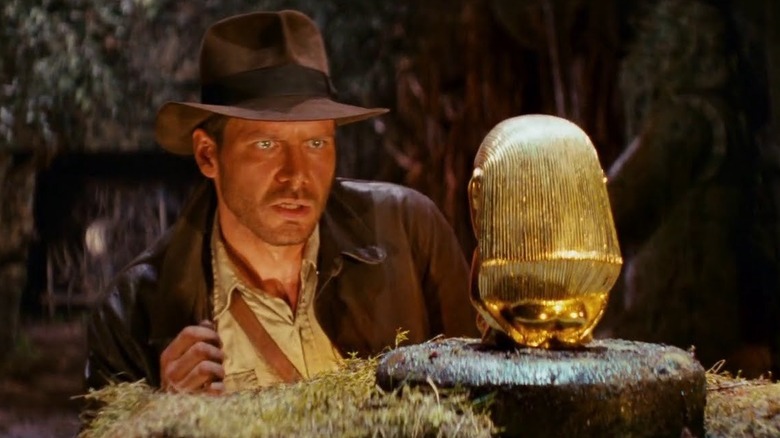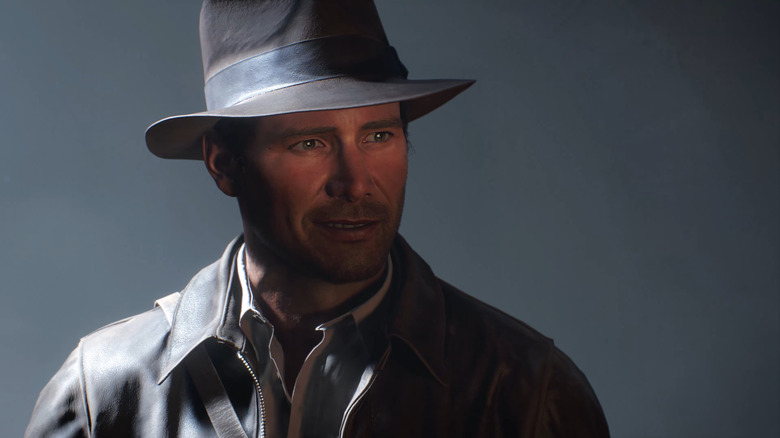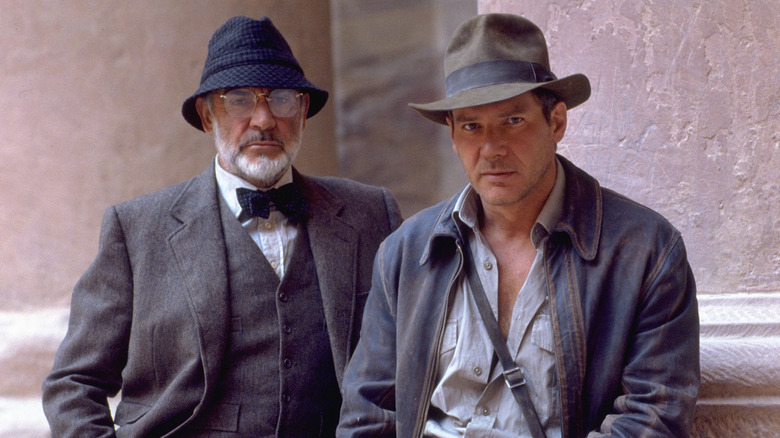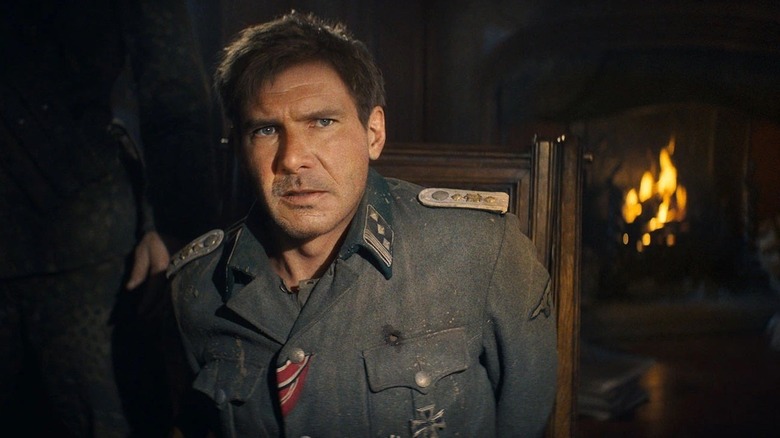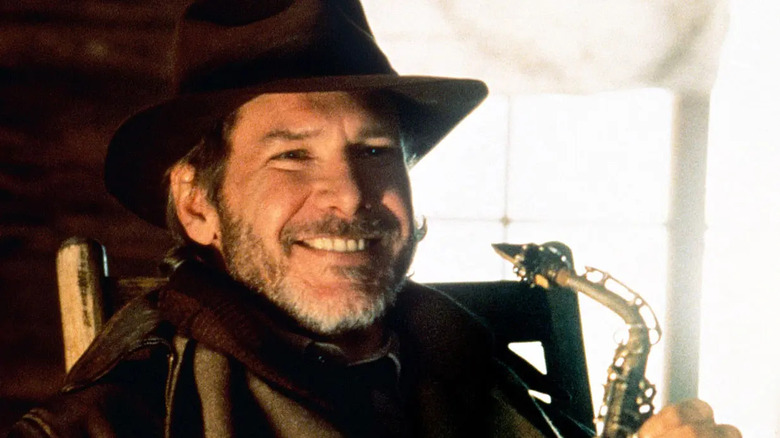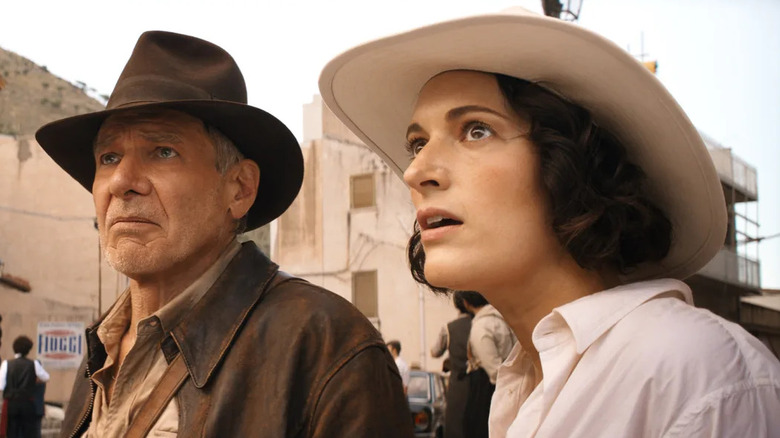The Complete Indiana Jones Timeline Explained
It's been 44 years since "Raiders of the Lost Ark" premiered in theaters. Many of the coolest moments from the "Indiana Jones" franchise (so far) have since become staples of pop culture and have been parodied over and over again. To some, the concept of a globe-trotting archaeologist may even be pastiche at this point.
And yet, in the years that the "Indiana Jones" franchise has grown since the release of "Raiders of the Lost Ark," the timeline of the movies and associated materials have gotten a little confusing to casual fans. Not only are the feature films in the franchise not in chronological order, but there's also an entire television series, "The Young Indiana Jones Chronicles," which aired on ABC from 1992 to 1996 and spans the entire life story of Harrison Ford's character in the films, as portrayed across the ages by Sean Patrick Flanery, George Hall, Corey Carrier, and Ford himself.
For those who want to know the exact chronological order of Indiana Jones' life on screen (not including additional media like novels, comic books, or video games aside from "Indiana Jones and the Great Circle"), this should be your definitive source of truth going forward. Just keep track of all the dates ... why does it have to be dates?
1908 - Indy's childhood adventures
"The Young Indiana Jones Chronicles" spans a wide range of time periods, from Indy's childhood to old age. The youngest incarnation of the character is played by Corey Carrier, with some of the essential episodes of young Indiana Jones' adventures taking place in early 1908. Among these is the show's very first episode, "Young Indiana Jones and the Curse of the Jackal," which aired in 1992.
In the episode, a nine-year-old Henry Walton Jones Jr. is on an expedition to Egypt with his family, including his dog Indiana and his tutor, Helen Seymour (Margaret Tyzack). In Egypt, Indy crosses paths with Lawrence of Arabia and Howard Carter, both real-life archaeologists noted for their contributions to Egyptian history. Unfortunately, Jones' role in this story is only as a spectator a la "Forrest Gump," predating Carter's own discovery of King Tut's tomb in 1922.
Other episodes of "The Young Indiana Jones Chronicles" see Jones exploring much of the world from 1908 to 1910, including his first foray with love in Vienna (with the daughter of Archduke Franz Ferdinand) and brushes with geniuses like Pablo Picasso. Oftentimes, he's accompanied by his parents, Anna Jones (Ruth de Sosa) and Henry Sr. (Lloyd Owen), the latter being a reputable professor of medieval history in his own right.
1912 - First scene of The Last Crusade
As far as theatrical "Indiana Jones" films go, "Indiana Jones and the Last Crusade" has the earliest depiction of Harrison Ford's iconic character at age 13 during the film's cold open. Living with his father in Utah, Jones is a boy scout who goes exploring (desperate to earn his father's attention) and happens upon the cross of Coronado, coming into conflict with a squad of fedora-wearing grave robbers. They give chase, forcing Indy to return the cross. Admiring the boy's tenacity, their leader lends Indy his fedora, which later becomes a part of the character's signature look.
During this sequence, a few key moments establish future staples of Indiana Jones' character. For starters, during the ensuing conflict, he draws blood on his chin, which would later remain etched into the character's look via a real scar on Harrison Ford's face. This chase sequence also established Indy's fear of snakes, after hiding on a circus train results in the character falling into a tub of garter snakes, covered in the slithery creatures.
Many fans consider "The Last Crusade" the greatest "Indiana Jones" movie, and a lot of that is due to this opening sequence, which gives a lot of context for why Indy is the way he is in those first three films. It's not just a matter of explaining signature parts of his look, but also of establishing his never-ending hunger for adventure as a way to prove himself to his father.
1916-1918 - The Young Indiana Jones Chronicles
The bulk of "The Young Indiana Jones Chronicles" stars Sean Patrick Flanery as the young adventurer from the ages of 16 to 21. The earliest we see 16-year-old Indiana Jones is in the series' first episode, which has an unexpected tie to his earlier trip to Egypt, recovering a jackal headpiece stolen from Ka's tomb during a skirmish with Mexican revolutionaries.
Jones' adventures in the latter half of the 1910s feature the character's involvement in World War I, fighting for the Belgian army, and being captured by the Germans alongside French general Charles De Gaulle. During his training in London, Jones proposes to a suffragette named Vicky, but she turns him down. In 1917, during the war, Jones is involved in the Battle of Beersheba. In 1918, Jones crosses paths with Ernest Hemingway and the reincarnation of Vlad the Impaler in Transylvania. His adventures in 1920 see Indy back in the States, working on Broadway and studying at the University of Chicago.
Though fans may clamor over the correct order to watch Indiana Jones' adventures in "The Young Indiana Jones Chronicles," given that the episodes are not in chronological order, few are relevant to the events of the film franchise.
1925 - Indy's relationship with Marion
Aside from Indiana Jones himself, the most iconic character to emerge from this Lucasfilms franchise is Marion Ravenwood, who first shows up in "Indiana Jones and the Raiders of the Lost Ark" by Karen Allen. Although she's Jones' sidekick and romantic interest in that film, their history goes back nearly an entire decade, to when Indy was the mentee of her father, archaeology professor Dr. Abner Ravenwood. It was during this time that Jones learned of Abner's fascination with the Ark of the Covenant.
When Indy and Marion met, he was 26 and she was 16, but despite this egregious age gap (and in part due to Marion's crush on Indy), they pursued a relationship together. According to various comic books and novelizations, their illicit affair ended abruptly when Marion's father learned of it, forcing Indy to leave her. Though he promised he'd come back, they never saw each other again until the events of "Raiders of the Lost Ark," leaving a sour taste in Marion's mouth about the young archaeologist.
The years that followed would see Indy become a professor of archaeology not unlike Ravenwood himself, while also beginning to moonlight as a respectable adventurer recovering artifacts and relics from across history. Nevertheless, Indy's brief romance with Marion would not only haunt him for the next decade, but for the rest of his life.
1935 - Temple of Doom
Although it's the second film released in the "Indiana Jones" franchise, "Indiana Jones and the Temple of Doom" is the first chronologically. Unlike "Raiders of the Lost Ark," "Temple of Doom" is front-to-back an adventure film. Jones and his sidekicks, Short Round (Ke Huy Quan) and Willie (Kate Capshaw), travel to the Indian village of Mayapore, where Jones is recruited to retrieve a stolen relic from a Thuggee cult.
Indy and his companions are later captured by the very same cult, whose leader Mola Ram forces Jones to drink the blood of the Indian deity Kali, seducing him into a trance-like state as he aids in the sacrifice of Willie. Thankfully, Short Round escapes captivity to free Indy from Mola Ram's spell and rescue Willie. Their escape results in "Temple of Doom's" rope bridge battle, one of the most memorable sequences in the entire "Indiana Jones" franchise.
After successfully retrieving the stones and returning them to the people of Mayapore, "Temple of Doom" ends. At some point in the next year of Jones' life, he parts ways with both Willie and Short Round and resumes his professorial duties at the fictional Marshall College, which funds his expeditions around the world — including the one that occurs in the very first theatrical appearance of Harrison Ford's character.
1936 - Raiders of the Lost Ark
The opening sequence of "Raiders of the Lost Ark" takes place in 1936, depicting an average adventure for Indiana Jones: the archaeologist narrowly escapes booby traps in a Peruvian temple before his rival, René Belloq (Paul Freeman), ambushes him and steals the valuable artifact he's just retrieved: a golden idol. Back at Marshall College, Jones is informed about the movements of the German Nazis in Egypt. After learning about the involvement of Abner Ravenwood, Jones realizes they're after the Ark of the Covenant, Ravenwood's white whale.
Jones subsequently travels to Nepal, where he reunites with Marion at the bar she owns. After the Nazis, led by Arnold Toht (Ronald Lacey), arrive, Jones helps Marion escape with the medallion needed to access the Ark's exact burial site. Indy and Marion race the Nazis to Cairo, using the real medallion and a staff to successfully find the Ark. Unfortunately, the Nazis are hot on their tail and capture Indy and Marion. The two of them ultimately become the only survivors of the Nazis opening the Ark, which kills everyone whose eyes are open as the spirits are released.
The ending of "Raiders of the Lost Ark" sees Jones not only rewarded for returning the Ark to archives in the United States, but mending his relationship with Marion. However, by the time the character is seen next chronologically on film, Marion's no longer in the picture — a decision that weighs heavily on the character in his most recently-released adventure: a video game.
1937 - The Great Circle
There have been plenty of "Indiana Jones" video games over the years, but "Indiana Jones and the Great Circle" is the first to feel like you're really playing an entirely new chapter of the archaeologist's story. Instead of Harrison Ford, the character is voiced by Troy Baker ("The Last of Us," "BioShock Infinite"), in an adventure set approximately one year after the events of "Raiders of the Lost Ark." In fact, the game's opening tutorial sequence is a shot-for-shot remake of the opening to "Raiders" (although it's revealed to be just a nightmare Indy's having.
"The Great Circle" answers a 44-year-old franchise question, taking place just after Indy has abruptly left Marion just before they were set to get married. This abandonment weighs heavily on him as he investigates a series of connections between several locations (Vatican City, Shanghai, Cairo, Himalayas, etc.) that form a perfect circle with a stolen artifact from Marshall College's archives. Indy discovers with the help of a thief, Locus, that the Great Circle also has connections to recurring flood myths in worldwide mythologies.
Though it's a very different experience actually playing as Indiana Jones versus watching the character in a movie or comic book, "The Great Circle" is not only fun but fills in a few important gaps between "Raiders" and the next film that comes chronologically in the "Indiana Jones" timeline.
1938 - The Last Crusade
Following the cold open that takes place in 1912, "Indiana Jones and the Last Crusade" picks up again in 1938, two years after the events of "Raiders," when Indy learns that his father Henry Sr. (Sean Connery) has disappeared during his search for the Holy Grail. Teaming up with his father's partner, Elsa (Alison Doody), Indy traces his father to a castle in Austria controlled by the Nazis. Indy and his father reunite just as Elsa betrays the duo, letting the Nazis capture them alive. Similarly to "Raiders," the duo escape and begin to race the Nazis to Hatay, where the Grail allegedly lies.
With the help of Marshall College colleague Marcus (Denholm Elliott), Indy and his father track down the Grail's location to a temple, where the Nazis (led by Julian Glover's corrupt businessman Walter Donovan), force Indy to lead them past booby traps to find the Grail. They eventually find a room filled with cups, with only one of them being the actual Grail. Elsa double-crosses somebody once again by giving Donovan the wrong cup to drink from and killing him.
After finding the right Holy Grail, Indy and his father escape from the temple just in the nick of time, accomplishing Henry Sr.'s lifelong goal of finding the Grail whilst also repairing their dysfunctional relationship.
1945 - Opening scene of Dial of Destiny
"Indiana Jones and the Dial of Destiny" is the most recent film in the franchise, and similarly to "The Last Crusade," it opens with an extended sequence that takes place decades before the main events of the movie. The action picks up in 1945, at the end of World War II, where Indy (played by Harrison Ford using de-aging CGI technology) has just been captured by Nazis alongside his sidekick, Basil Shaw (Toby Jones), during their heist of the Lance of Longinus.
After discovering the lance that the Nazis are in possession of is a fake, Jones and Shaw learn from Nazi scientist Jürgen Voller (Mads Mikkelsen) that they're in possession of a much more valuable artifact: Archimedes' dial, a mechanism built by the Syracusan polymath that can allegedly allow for time travel through the discovery of time fissures. In typical Indiana Jones fashion, the archaeologist frees himself, escapes from the Nazi's imprisonment and, along with Shaw, steals back Archimedes' dial.
Shortly after the events of this cold open, as revealed in a flashback sequence later on in "Dial of Destiny," Jones and Shaw had a falling-out over Shaw's obsession with the dial. As witnessed by Shaw's daughter, Helena (Phoebe Waller-Bridge), he implores Indy to destroy the dial for the betterment of mankind. But typical for Jones, he keeps it archived, allowing for the events of "Dial of Destiny" to occur many years later.
1950 - Middle-aged Indy in The Young Indiana Jones Chronicles
Harrison Ford made one appearance in "The Young Indiana Jones Chronicles," portraying a much older version of the archaeologist than any of the original trilogy of films had depicted. This episode in the series' second season was "Young Indiana Jones and the Mystery of the Blues," which features a framing device for the episode set in 1950. Indiana Jones, accompanied by a Native American companion named Greycloud, is in a snowed-in cabin in Wyoming after recovering a native relic of Greycloud's tribe: a peace pipe.
Inside the cabin, Jones happens upon a soprano saxophone, which reminds him of his adventures in Chicago in 1920. This makes for most of the episode's action, as the 50-year-old Indiana Jones regales Greycloud with the story while they wait for the snowstorm to pass. Afterwards, Indy and Greycloud are ambushed inside the cabin by a group of thieves, who steal back the peace pipe and take off. However, Indy is able to subdue the thieves with the aforementioned saxophone, playing a note loud enough to knock them down with falling snow.
Indy recovers the peace pipe and gives it to Greycloud before they both head on their way to parts unknown. It may not be the most action-packed adventure of Indy's life, but given it's the one appearance of Ford in the ABC series, it's worth a mention.
1957 - Kingdom of the Crystal Skull
"Indiana Jones and the Kingdom of the Crystal Skull" might be the most divisive entry in the "Indiana Jones" film franchise, but as the years have passed, it's gotten retroactive praise for being actually good — so put that in your fridge and nuke it. The film is set in 1957, opening on a sequence where Jones and his companion, Mac (Ray Winstone), recover a mummified alien from Area 51, only for Jones to get betrayed and narrowly avoid death by atomic bomb test by hiding in a lead refrigerator.
Back at Marshall College, Jones meets a greaser by the name of Mutt Williams (Shia LaBeouf), who informs Indy of the location of a crystal skull in Peru. Intrigued (and on the run from Soviet agents), Indy and Mutt travel to Peru, meeting Mutt's colleague Ox (John Hurt) and Mutt's mother, who happens to be Marion Ravenwood. The bigger discovery of Indy's life in this adventure isn't any crystal skull: it's that Mutt is his biological son.
Indy eventually is able to retrieve the crystal skull and evade the Soviets, only for the entire alien skeleton to remorph into a living creature and depart from Peru in a UFO. Back at Marshall College, Indy finally marries Marion and gives his hat to Mutt, promising a new generation of exploration in his son's future. However, as audiences would learn in the eventual fifth "Indiana Jones" movie, Mutt's adventures didn't last very long.
1969 - Dial of Destiny
Prior to the events of "Dial of Destiny," Mutt sadly dies in the Vietnam War and Indy separates from Marion as a result of his guilt. The story picks up in 1969, where Indy is teaching at Hunter College. After Helena Shaw appears asking questions about Archimedes' dial, which is archived at Hunter College, Helena double-crosses her godfather and takes off with the dial.
Indy tracks Helena to Morocco, thwarting her attempts to sell the dial on the black market. Unbeknownst to her, the Nazi scientists who Indy stole the dial from are after it, planning to travel back in time and help the Germans win World War II. Indy and Helena locate the other half of Archimedes' dial in the polymath's tomb, but Voller and the Nazis catch up to them and steal the dial back.
However, the Nazis miscalculate how the Dial of Destiny works, failing to travel back to 1939 and instead end up at the Siege of Syracuse in 214 BC. The Nazis' plane is shot down, and a surviving Indy and Helena encounter the one and only Archimedes (Nasser Memarzia), who lends them his dial in exchange for Voller's wristwatch. Indy initially plans to stay in 214 BC and die amongst history, but Helena doesn't let him, knocking him unconscious. Indy reawakens in his New York City apartment, where Helena has invited Marion to return and nurse him back to health. Hopefully, this time, adventure won't take Indy away from her.
